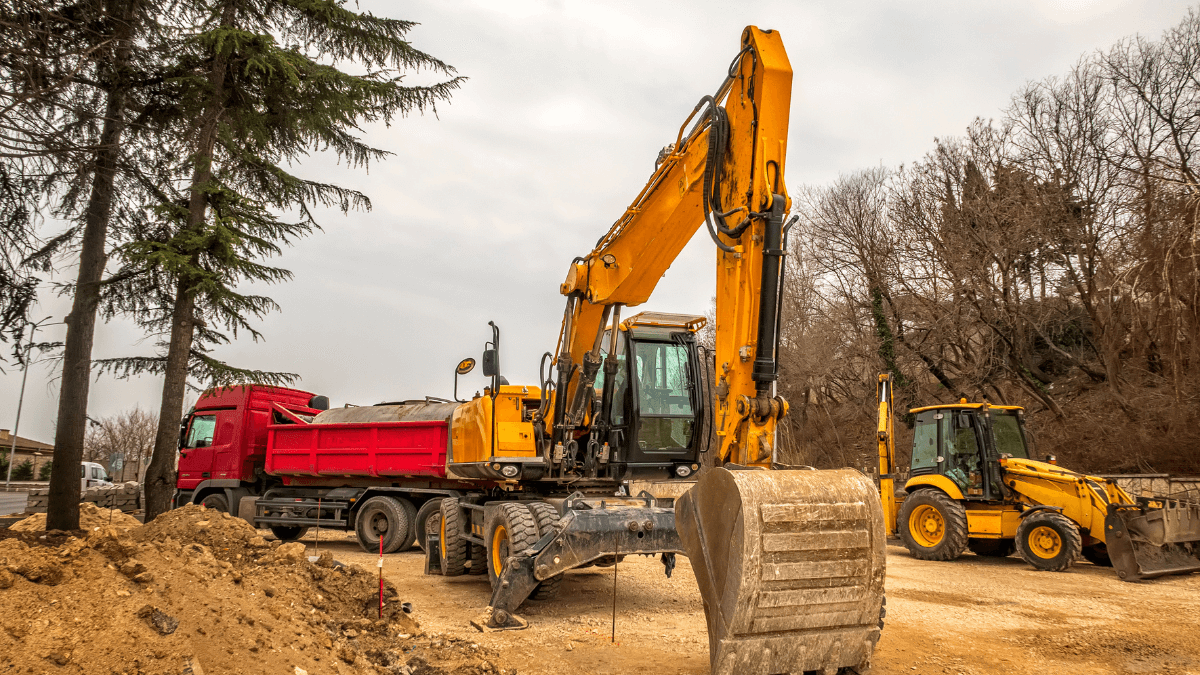To better protect your assets and employees’ personal items, it’s important to understand the root causes of construction equipment theft.
Equipment theft happens for a variety of reasons.
These reasons include the current high demand for construction equipment and raw materials, as well as the fact that construction equipment is highly valuable no matter which model it is, and regardless of whether it’s used or not.
The fact that stolen construction equipment also has low recovery rates is another contributing factor.
Finally, most construction sites lack proper security measures, and technological advances allow thieves new ways to work.
In the following sections, we’ll go over the key reasons why construction equipment theft happens and suggest some ways to combat it.
In this article...
Construction Equipment Is in High Demand
Construction equipment theft is one of the most frustrating aspects of the industry.
After contractors have spent a great deal of time researching which tools and fleet vehicles will best serve their company–and maybe even after clients have begun installing brand-new appliances or HVAC– thieves can quickly wipe out everyone’s hard work.
Thieves tend to target construction equipment because it offers a high payout, which makes it seem worth the risk of arrest.
This is because the construction equipment market has been on the rise for a long time, and the trend is projected to continue well into the future, as this graph shows:
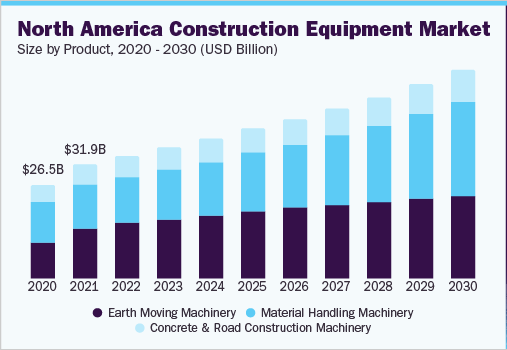
Source: Grand View Research
The construction equipment market is lucrative even beyond North America, making equipment theft a global problem.
According to Allianz, in England, for example, £17.5 million (or $21 million) worth of tools was stolen in London alone.
Opportunistic and organized thieves know that they can quickly find a buyer for illegally obtained goods.
Moreover, past thefts can provide improved surveillance and coordination for the next strike.
Nevertheless, companies can do a lot to prevent theft by improving on-site security and investing in equipment tracking solutions that make a note of an item’s last known location and handler.
Doing so promotes accountability and helps the authorities conduct an investigation if the need arises.
Purchasing Used Equipment Is Popular
Several circumstances are contributing to a rise in demand for used construction equipment.
Because of the ongoing housing shortage, there is an increase in remodeling and even new construction projects.
While it means plenty of work for the construction industry, this economic reality brings challenges of its own.
The global supply chain is still recovering from the COVID-19 pandemic. At the same time, just like in nearly every other industry, finding dependable labor is difficult for contractors.
In addition, high inflation is eating away at many companies’ profit margins.
Because of this, many contractors opt for purchasing used equipment instead of new models, as this represents the more affordable option.
The increasingly lucrative used equipment market means that thieves are more motivated to steal construction equipment and fraudulently sell it off as second-hand equipment.
The good news about this market shift is that organizations seeking to offload unused items can collect a profit larger than they otherwise might.
Unfortunately, the other side of the situation is that companies and contractors must take extra measures to secure work sites and assets.
It is also advisable for the buyer to check the chain of custody for the used equipment that they’re purchasing, to make sure it is being obtained from legitimate sources.
Construction Equipment Is Very Valuable
According to Equipment World, construction equipment prices have shot up 6% since 2021, reaching record values.

Source: KHL Group
How does this correlate to the value of stolen construction equipment?
A great deal of money is changing hands in the construction market, which in turn pulls in the attention of those seeking a way to make money quickly and illicitly.
As cited by Construction Connect, the National Equipment Register places the estimated amount of annual stolen equipment between $300 million and $1 billion.
Although those numbers are enormous, they refer only to stolen equipment such as backhoes, loaders, and cement mixers.
A wide variety of other items, ranging from raw materials, smaller tools such as nail guns, and pre-installed consumer items like washer/dryer sets or copper wiring also get taken, meaning that the total value of stolen goods is even higher.
Therefore, tracking your equipment, establishing a check-in/check-out system that helps keep track of who had the equipment in their possession and when, and taking other security measures, are well worth the effort and the resources you invest in them.
Stolen Equipment Has Low Recovery Rates
Construction Connect, which we’ve already quoted in the previous section, reports that if your construction company is the victim of equipment theft, you have less than a 25% chance of ever seeing the stolen items again.
This one statistic provides a window on the notoriously low success rate in recovering construction equipment, but there’s much more to consider.
For an even more comprehensive—and more sobering—idea of the prevalence of construction theft, have a look at recovery rates, damage reports, and associate costs from Datoms:
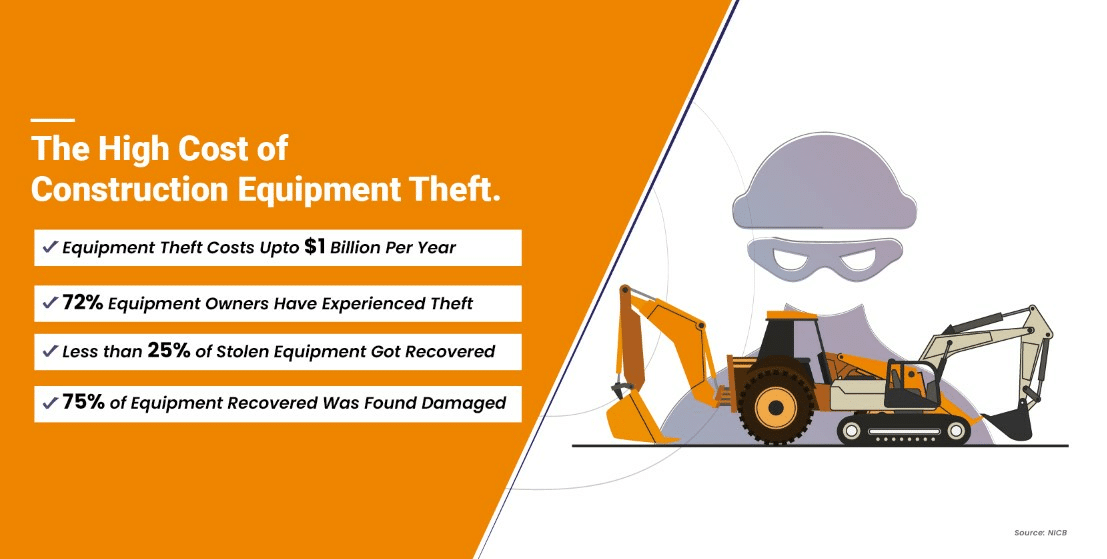
Source: Datoms
Even if the odds are with the company and the stolen goods are somehow recovered, it’s a good bet that the items are somehow damaged or will require a long and expensive reintegration process.
In the event the items require replacement or even repair, higher insurance rates are sure to follow.
What is more, bringing in law enforcement, filing claims, and allowing investigators a chance to examine the crime scene means that construction site thieves can have a head start on victim companies of a week or more.
By the time an investigation is launched, the items are likely far from the scene, or they were already sold at auction or disassembled for parts.
Either way, the more time that goes by and the more hands through which the assets pass, the lower the chances that your equipment will make its way back to you.
Many thieves can peel off security decals or remove license plates in a matter of seconds.
Even if the items themselves are recovered, the chance of tracking down the original thieves or those fencing stolen property is even lower, and construction site thieves can rack up tens of thousands of dollars in as little as four hours.
It is best to prevent theft from happening, for instance, by using GPS to set up a geofencing system.
Geofencing can serve as an early warning system, alerting construction managers as soon as a piece of equipment leaves the jobsite or shows signs of activity outside of operating hours, and thus increasing the likelihood of catching those responsible and retrieving stolen equipment.
Many Companies Practice Poor Record-Keeping
Proactive record-keeping has many positive aspects, such as better efficiency, more personalized customer service, and more reliable equipment.
Conversely, poor record-keeping can even contribute to lack of site safety.
Many construction company owners and contractors are not aware that they are their own worst enemies when it comes to record-keeping.
Something so mundane might not sound like a crime deterrent, but tracking fixed as well as non-fixed construction assets is the first line of defense between your company and ill-intentioned people.
The tips from the Puget Sound ATTF listed below show how much poor record-keeping can figure into heavy losses due to theft:
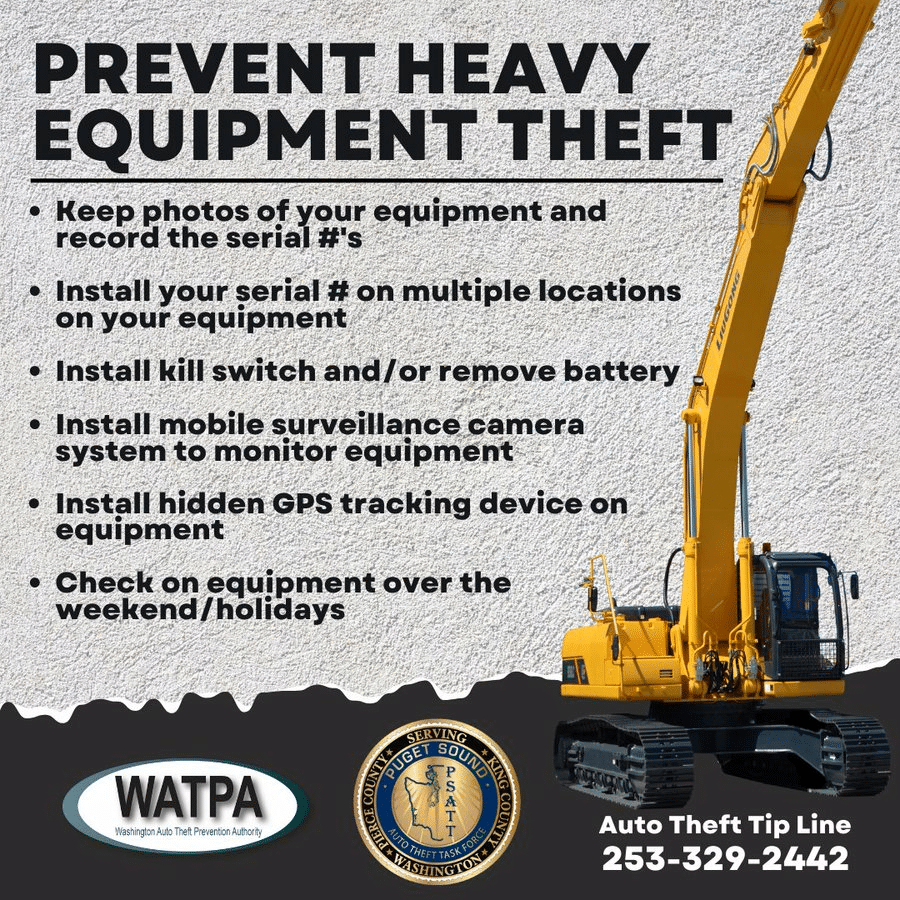
Source: Puget Sound ATTF
By failing to track your assets—which, if you have chosen the right system, will store your data securely in the cloud—you might not even notice if the equipment has moved from the site, or if it is emitting regular data transmissions that can alert you of unauthorized movement.
Poor record-keeping means that if even you have thought to take photos of your equipment and write down their serial numbers, you might not know this information at all, or you might be unable to quickly lay hands on it to pass to law enforcement.
Due to all of these delays and gaps in knowledge, your equipment might remain out of your hands.
Sometimes, third party contractors or direct employees are part of a theft operation.
In exchange for part of the take, they might offer information to criminals about which assets are vulnerable and how to exploit weaknesses in site security.
Most tellingly, if a thief somehow learns that the construction company does not keep up-to-date records of all their equipment, those untracked assets are more at risk.
To the wrongdoers, items that vanish from a warehouse or build site are worth the time and the risk to steal, because managers or security staff might not realize the equipment is even gone for quite a while.
In summary, implementing proper record-keeping practices that make it clear when something is out of order is vital for keeping your equipment safe from theft.
There Is a Lack of Proper Security Measures
One of the months which is most active for criminal activity on construction sites is January, which might sound surprising, as it’s a good bet that most of the construction activity in the Northern Hemisphere is at a minimum at that time.
However, that’s precisely why thieves like to strike in the middle of the winter.
They know that sites are rarely checked in periods of low construction activity.
Since many construction sites fail to provide such simple security measures as flood lights or locked gages, thieves are more likely to target them.
Sites that do as little as take the time to alert trespassers that assets are tagged or part of a national database are less likely to experience repeated theft.
Some simple security measures you can undertake on your construction site include:
- Automated asset tracking
- Asset tracking with GPS tags
- Visible security cameras
- Bright lighting
- Security guards
- Locked fences
- GPS fencing
- Locked and controlled tool cribs
GoCodes can offer these advantages of asset tracking, as well as many more.
Not only does GoCodes offer tool and equipment tracking software to ease employee tool check-in, asset movement, and data analysis, its individualized asset tags with QR codes are quickly and easily scanned to reveal the location of your equipment.
Here’s an example:
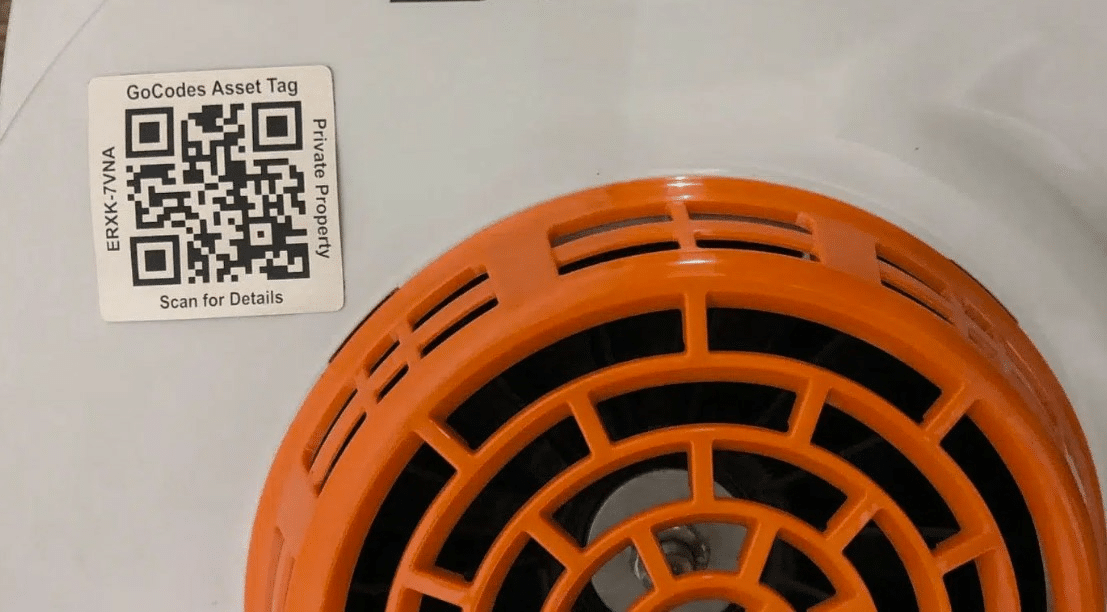
Source: GoCodes
These codes are randomly generated so that each one is unique to the item and tag, which eliminates the possibility of confusion and wasted time.
They are also easily welded or otherwise attached to rugged, heavy items which see all matter of weather, temperatures, vibration amounts, and elevation differentials.
By using such strong organizational tactics, you and your team will likely notice much faster if some of your valuable equipment is not where it should be.
Thieves Are Using Smarter Tactics
When thieves are aware how likely they are to undergo capture while transporting or loading stolen goods, they usually take the time to examine a vulnerable construction site.
They learn which items are worth stealing and how they can best dodge security measures.
Despite this, some construction companies fail to take more than basic identity theft measures regarding their equipment because they think that physical assets are not connected to these crimes.
However, Rural Mutual points out that identity theft can enable thieves to pick up, steal, or order equipment by fraudulently using your company’s name or data:

Source: Rural Mutual
In other words, failing to protect yourself from identity theft represents a weak point
Some criminals use fake IDs to set up fraudulent equipment rental accounts or order replacement keys online for popular equipment models.
Others follow social media accounts to see where builds are taking place and at which stage construction is or order license plates for vehicles that do not exist.
Moreover, some even patiently wait for security vulnerabilities, such as crews failing to replace heavy concrete barriers that were temporarily moved to allow for a delivery.
Conclusion
The high cost of construction site theft means that constant vigilance is necessary—not only on the build site, but within employee records and at warehouses.
Construction equipment is valuable and in high demand.
It is easy to offload used equipment in the current economic climate, and stolen construction equipment has low recovery rates.
Poor record-keeping and lack of basic security measures can invite thieves to consider stealing your assets.
Finally, since thieves are becoming more technologically savvy, it’s important to stay informed about new tactics and forms of identity theft.
We hope that this article has provided you with some valuable insights concerning the causes of construction equipment theft and the steps you can take to protect your company from it.

